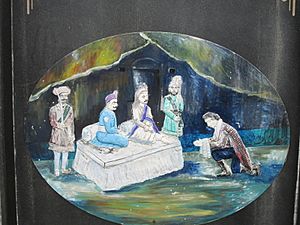Battle of Wadgaon facts for kids
Quick facts for kids Battle of Wadgaon |
|||||||
|---|---|---|---|---|---|---|---|
 A painting showing the British giving up during the First Anglo-Maratha War. It's part of a Victory Memorial in Vadgaon Maval. |
|||||||
|
|||||||
| Belligerents | |||||||
| Commanders and leaders | |||||||
| Mahadji Shinde Tukoji Rao Holkar Nana Fadnavis |
Thomas Goddard Captain James Stuart Colonol Charles Egerton Lt. Col Cay Lt. Col Cockburn Raghunathrao |
||||||
| Strength | |||||||
| 4,000 British soldiers with cannons small groups of soldiers with Raghunath Rao |
|||||||
The Battle of Wadgaon happened on January 12–13, 1779. It was a fight between the powerful Maratha Empire and the British East India Company. This battle took place near the village of Vadgaon Maval in Maharashtra, India. It was an important part of the First Anglo-Maratha War.
Contents
Why the Battle Happened
The city of Bombay (Mumbai) had been under British control since 1661. In the late 1700s, the Maratha Empire was growing strong. The British felt they needed to protect Bombay. They also wanted to control the paths that supplied goods to Bombay. These paths came from Bassein (now Vasai) in the north and Pune in the east. Both of these areas were part of the Maratha Empire.
Also, the Marathas started talking with the French. This worried the British a lot. To achieve their goals, the British made a deal. On March 6, 1775, they signed the Treaty of Surat with Raghunathrao. He wanted to become the Peshwa, a top leader of the Marathas. The treaty said that if Raghunathrao became Peshwa, he would give Salsette and Bassein Fort to the British.
British March to Pune
The British military campaign started in November 1778. British forces, led by Captain James Stewart and Colonel Charles Egerton, marched from Mumbai. Their goal was to reach Pune. They traveled through the Bor Ghat mountain pass. This pass was also used by Shivaji, a famous Maratha king.
Colonel Egerton captured Belapur Fort and set up a base at Panvel. Captain Stuart moved ahead to Khandala. The British army had about 4,000 soldiers. They also had cannons and gunners. Raghunathrao joined them with his own smaller groups of soldiers. The British thought that Nana Phadnis, a Maratha leader, would fight them in Pune with a large army. They also believed that other Maratha leaders, Shinde and Holkar, would leave Pune and join Raghunathrao. Both of these ideas turned out to be wrong for the British.
From Panvel, Colonel Egerton reached Khopoli. He set up another British base there in late 1778. Captain James Stuart had already reached Khandala village. He made a camp at the top of the mountain pass. By mid-December, a large British force had gathered there. Colonel Egerton then split his forces between Lieutenant Colonel Cay and Lieutenant Colonel Cockburn. The British had not faced any resistance from the Marathas during their march. This made them feel very confident.
Getting Ready for Battle
The British East India Company's army from Bombay had about 3,900 soldiers. Around 600 of them were Europeans, and the rest were Asian. Thousands of helpers and workers also came with them. On their way, Raghunathrao's soldiers joined them, adding thousands more. They also brought more cannons.
The Maratha army was much larger. It included soldiers from all parts of their empire. There were tens of thousands of Maratha soldiers. They were led by Tukojirao Holkar and General Mahadji Shinde.
Mahadji Shinde slowed down the British march. He sent his forces to the west to cut off the British supply lines. When the British found this out, they stopped at Talegaon. This town was a few hours' walk from Pune. But it was days away for their thousands of support staff and ox-drawn carts. The Maratha cavalry then attacked the British from all directions. The Marathas also used a "scorched earth" tactic. This meant they emptied villages, took all the food, burned farms, and poisoned wells. This made it very hard for the British to find supplies.
The Battle of Wadgaon
The British started to leave Talegaon in the middle of the night. But the Marathas attacked them. This forced the British to stop in the village of Wadgaon (now called Vadgaon or Vadgaon Maval). The Maratha forces surrounded the British army on January 12, 1779.
By the end of the next day, the British were ready to talk about giving up. On January 16, they signed the 'Treaty of Wadgaon'. This treaty made the Bombay government give up all the lands it had taken since 1773. It also stopped a British army that was marching towards Pune from Bengal. The British also had to agree to share money from the Broach area.
What Happened After
The Marathas, showing respect, allowed the British to go back to Bombay. Some historians believe this was a big mistake. British historian James Douglas said that if Nana Fadnavis had been like Napoleon or Edward I, no British soldier would have survived. He thought this would have changed the whole history of India.
The Treaty of Wadgaon did not last long. The British Governor-General in Bengal, Warren Hastings, said the treaty was not valid. He argued that the Bombay officials did not have the power to sign it. He then ordered that British interests in the area must be protected.
Remembering the Victory
In 2003, a group called 'Express Nagrik Vadgaon Vijaystambh Pratishthan' put up a victory pillar. This pillar remembers the Maratha victory in the Battle of Wadgaon. The victory at Wadgaon is still celebrated in the region every year.

